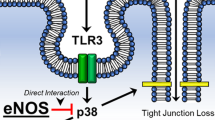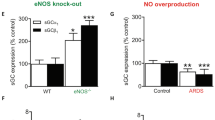Abstract
Monocyte chemoattractant protein-1 (MCP-1) is a pivotal mediator of angiocentric granuloma formation in glucan-induced pulmonary granulomatous vasculitis. Based on the rationale that mononuclear phagocytes retrieved from granulomas are rich sources of nitric oxide (NO) and that the recruitment of mononuclear phagocytes into lesions abates as granuloma formation slows, we tested the hypothesis that MCP-1 gene expression is regulated by a NO-sensitive mechanism. Preexposure of endothelial cell (EC) monolayers to NO donor compounds markedly reduced cytokine-induced MCP-1 expression and cytosolic-to-nuclear translocation of nuclear factor-kappa B (NF-κB), reversed fluctuations in endothelial reduced glutathione (GSH) pools but did not affect cGMP concentrations. The lungs of mice bearing targeted disruptions of the inducible nitric oxide synthase (iNOS) gene exhibited significantly higher concentrations of MCP-1 following glucan infusion than did those of wild-type mice. Cumulatively, these data suggest that NO suppresses MCP-1 expression by blunting the redox changes associated with cytokine-induced EC activation.
Similar content being viewed by others
References
Robinson, D. S., L. Richeldi, C. Saltini, and R. M. Du Bois. 1997. Granulamatous processes. In: The Lung: Scientific Foundations, 2nd edn., R. G. Crystal, J. B. West, E.R. Weibel, and P. J. Barnes, eds., Lippincott-Raven, Philadelphia, pp. 2395–2409.
Strieter, R. M. and S. L. Kunkel. 1997. Chemokines. In: The lung: Scientific foundations, 2nd edn., R. G. Crystal, J. B. West, E.R. Weibel, and P. J. Barnes, eds. Lippincott-Raven, Philadelphia, pp. 155–186.
Rollins, B. R., T. Yoshimura, E. L. Leonard, and J. S. Pober. 1990. Cytokine-activated human endothelial cells synthesize and secrete a monocyte chemoattractant, MCP-1/JE. Am. J. Pathol. 136(6):1229–1233.
Flory, C. M., M. L. Jones, and J. S. Warren. 1993. Pulmonary granuloma formation in the rat is partially dependent on monocyte chemoattractant protein–1. Lab. Invest. 69(4):396–404.
Flory, C. M, M. L. Jones, B. F. Miller, and J. S. Warren. 1995. Regulatory roles of tumor necrosis factor-α and interleukin-1β in monocyte chemoattractant protein-1-mediated pulmonary granuloma formation in the rat. Am. J. Pathol. 146:450–462.
Jones, M. L. and J. S. Warren. 1992. Monocyte chemoattractant protein 1 in a rat model of pulmonary granulomatosis. Lab. Invest. 66(4):498–503.
Kilgore, K. S., M. M Imlay, J. P. Szaflarski, F. S. Silverstein, A. Malani, V. M. Evans, and J. S. Warren. 1997. Neutrophils and reactive oxygen intermediates mediate glucan-induced pulmonary granuloma formation through the local induction of monocyte chemoattractant protein-1. Lab. Invest. 76(2):191–201.
Kilgore, K. S., K. L. Powers, M. M. Imlay, A. Malani, D. I. Allen, J. T. Beyer, M. B. Anderson, and J. S. Warren. 1998. The carbohydrate sialyl Lewis(x) (sLe(x)) sulfated glycomimetic GM2941 attenuates glucan-induced pulmonary granulomatous vasculitis in the rat. J. Pharmacol. Exp. Ther. 286(1):439–446.
Desai, A., X. Huang, and J. S. Warren. 1999. Intracellular glutathione redox status modulates MCP-1 expression in pulmonary granulomatous vasculitis. Lab. Invest. 79(7):837–847.
Wynyard, P. G. and D. R. Blake. 1997. Antioxidants, redox-regulated transcription factors, and inflammation. Adv. Pharmacol. 38:403–421.
Desai, A., M. J. Miller, H. F. Gomez, and J. S. Warren. 1999. Loxosceles deserta spider venom induces NF-κB-dependent chemokine production by endothelial cells. Clin. Toxical. 37(4):447–456.
Hrabie, J. A., J. R. Klose, and D. A. Wink. 1993. New nitric-oxide releasing zwitterions derived from polyamines. J. Org. Chem. 58:1472–1476.
Desai, A., H. A. Lankford, and J. S. Warren. 2001. Homocysteine augments cytokine-induced chemokine expression in human vascular smooth muscle cells: Implications for atherogenesis. Inflammation 25(3):179–186.
Smith, P. K., R. I. Krohn, G. T. Hermanso, A. K. Mallia, A. K. Gartner, E. K. Provenzano, E. K. Fujimoto, N. M. Goeke, B. J. Olson, and D. C. Klenk. 1985. Measurement of protein using bicinchoninic acid. Anal. Biochem. 150:76–85.
Linton, M. and P. S. Gallo Jr. 1975. The Practical Statistician: Simplified Handbook of Statistics. Brooks/Cole, Monterey, CA.
Martin, T., P. M. Cardarelli, G. C. N. Parry, K. A. Felts, and R. R. Cobb. 1997. Cytokine induction of monocyte chemoattractant protein-1 gene expression in human endothelial cells depends on the cooperative action of NF-κB and AP-1. Eur. J. Immunol. 27(5):1091–1097.
Murad, F. 1994. Regulation of cytosolic guanylyl cyclase by nitric oxide: the NO-cyclic GMP signal transduction system. Adv. Pharmacol. 26:19–33.
Zeiher, A. M., B. Fisslthaler, B. Schray-Utz, and R. Busse. 1995. Nitric oxide modulates the expression of monocyte chemoattractant protein 1 in cultured human endothelial cells. Circ. Res. 76:980–986.
Tsao, P. S., B. Wang, R. Buitrago, J. Y. Shyy, and J. P. Cooke. 1997. Nitric oxide regulates monocyte chemotactic protein-1. Circulation 96:934–940.
Khan, B. V., D. G. Harrison, M. T. Olbrych, R. W. Alexander, and R. M. Medford. 1996. Nitric oxide regulates vascular cell adhesion molecule 1 gene expression and redox-sensitive transcriptional events in human vascular endothelial cells. Proc. Natl. Acad. Sci. 93(17):9114–9119.
Katsuyama, K., M. Shichiri, F. Marumo, and Y. Hirata. 1998. NO inhibits cytokine-induced iNOS expression and NF-κB activaton by interfering with phosphorylation and degradation of IκB-α. Arterioscler. Thromb. Vasc. Biol. 18:1796–1802.
Peng, H., P. Libbey, and J. K. Liao. 1995. Induction and stabilization of IκB-α by nitric oxide mediates inhibition of NF-κB. J. Biol. Chem. 270(23):14214–14219.
Janssen-Heininger, Y. M., N. E. Poynter, and P. A. Baeuerle. 2000. Recent advances towards understanding redox-mechanisms in the activation of nuclear factor κB. Free Radic. Biol. Med. 28(9):1317–1327.
Umansky, V., S. P. Hehner, A. Dumont, T. G. Hofmann, V. Schirrmacher, W. Droge, and M. Lienhard Schmitz. 1998. Co-stimulatory effect of nitric oxide on endothelial NF-κB implies a physiological self-amplifying mechanism. Eur. J. Immunol. 28:2276–2282.
Xie, Q. W., Y. Kashiwabara, and C. Nathan. 1994. Role of transcription factor NF-kappa B/Rel in induction of nitric oxide synthase. J. Biol. Chem. 269(7):4705–4708.
Niu, X. F., C. W. Smith, and P. Kubes. 1994. Intracellular oxidative stress induced by nitric oxide synthesis inhibition increases endothelial cell adhesion to neutrophils. Circ. Res. 74(6):1133–1140.
Author information
Authors and Affiliations
Corresponding author
Rights and permissions
About this article
Cite this article
Desai, A., Miller, M.J., Huang, X. et al. Nitric Oxide Modulates MCP-1 Expression in Endothelial Cells: Implications for the Pathogenesis of Pulmonary Granulomatous Vasculitis. Inflammation 27, 213–223 (2003). https://doi.org/10.1023/A:1025036530605
Issue Date:
DOI: https://doi.org/10.1023/A:1025036530605




